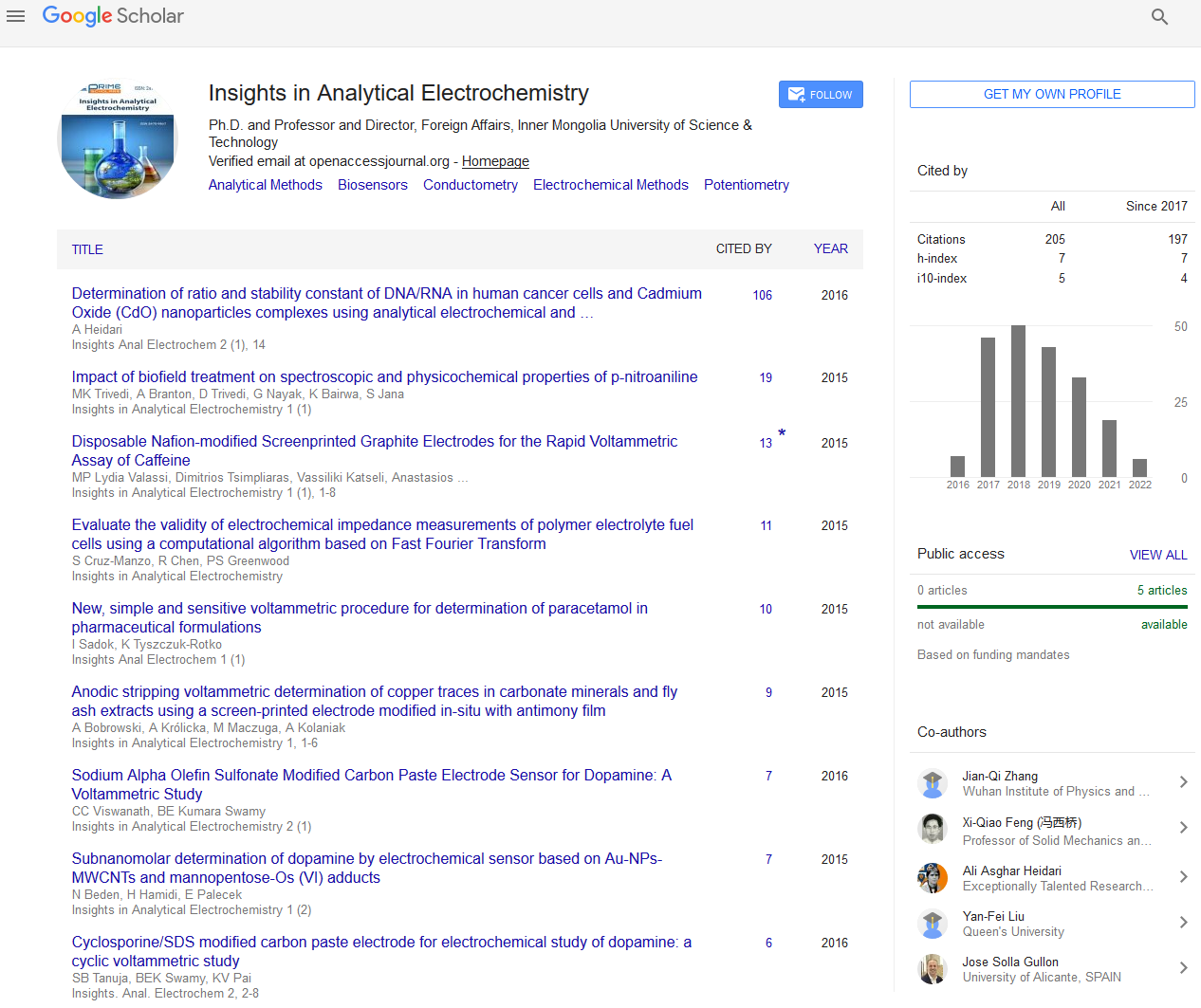Short Communication - (2023) Volume 9, Issue 4
Unlocking Precision: The Intricacies and Applications of Electrogravimetry
Elena Rodriguez*
Department of Nutritional Sciences, Institute of Health Sciences, Spain
*Correspondence:
Elena Rodriguez,
Department of Nutritional Sciences, Institute of Health Sciences,
Spain,
Email:
Received: 29-Nov-2023, Manuscript No. ipaei-24-18842;
Editor assigned: 01-Dec-2023, Pre QC No. ipaei-24-18842 (PQ);
Reviewed: 15-Dec-2023, QC No. ipaei-24-18842;
Revised: 20-Dec-2023, Manuscript No. ipaei-24-18842 (R);
Published:
27-Dec-2023, DOI: 10.21767/2470-9867-9.4.31
Introduction
Electrogravimetry, a powerful analytical technique at the
intersection of electrochemistry and gravimetry, stands as a
testament to human ingenuity in unraveling the mysteries of
matter at the molecular level. This method, born out of the
19th century scientific fervor, has evolved into a crucial tool
for researchers and analysts seeking precision in quantitative
analysis. At its core, electrogravimetry involves the deposition
of a solid metal from a solution onto an electrode surface
through an electrochemical reaction. The process hinges on the
fundamental principle that the amount of substance deposited
is directly proportional to the amount of electricity passed
through the solution. This electrochemical deposition offers a
means to measure the concentration of a specific element with
unparalleled accuracy.
Description
One of the key strengths of electrogravimetry lies in its ability
to provide highly precise results, making it an invaluable
asset in various fields such as environmental monitoring,
pharmaceuticals, and metallurgy. The method’s reliance on
the controlled deposition of metals enables researchers to
obtain data with low margins of error, a critical factor in fields
where minute quantities can have significant implications.
In environmental science, electrogravimetry plays a pivotal
role in assessing trace metal concentrations in water and soil
samples. The technique’s sensitivity allows for the detection
of pollutants at levels that might escape other methods. For
instance, monitoring heavy metal concentrations in water
bodies becomes more effective with electrogravimetry, aiding in
the preservation of aquatic ecosystems and ensuring the safety
of drinking water [1]. In the pharmaceutical industry, where
precision is paramount, electrogravimetry finds application
in the determination of metal impurities in pharmaceutical
products. The meticulous nature of the technique ensures
that pharmaceutical formulations adhere to stringent quality
standards, safeguarding public health and bolstering consumer
confidence. Metallurgy, the science of extracting metals from
their ores and modifying them for use, benefits significantly
from electrogravimetry. The method aids in the analysis of
ore samples, guiding metallurgists in optimizing extraction
processes and ensuring the purity of the final product. This
application is crucial not only for the efficiency of industrial
processes but also for maintaining the structural integrity
of materials in various applications, from construction
to aerospace [2]. However, like any scientific method,
electrogravimetry is not without its challenges and limitations.
The technique’s precision is heavily reliant on maintaining
ideal experimental conditions, including temperature, pH,
and electrode potential. Deviations from these conditions can
introduce errors into the results, emphasizing the need for
meticulous attention to detail in the laboratory. Furthermore,
the method is often time-consuming, with the deposition
process taking hours or even days to complete. This inherent
sluggishness can be a hindrance in fields where rapid analysis
is essential. Researchers continually seek to address these
challenges through technological advancements and the
development of automated systems, striving to enhance the
efficiency of electrogravimetric analyses [3,4].
Conclusion
In conclusion, electrogravimetry stands as a cornerstone
in the realm of analytical chemistry, offering unparalleled
precision in the determination of metal concentrations.
Its applications span diverse fields, from safeguarding the
environment to ensuring the purity of pharmaceuticals and optimizing industrial processes. As technology progresses,
the refinement of electrogravimetric techniques promises
to elevate its prominence further, solidifying its status as an
indispensable tool for researchers and analysts alike. The fusion
of electrochemistry and gravimetry continues to unlock new
frontiers in our understanding of matter, paving the way for
advancements that will shape the future of analytical science.
Acknowledgement
None.
Conflict Of Interest
The author’s declared that they have no conflict of interest.
References
- Ha LD, Park K, Chang BY, Hwang S (2019) Implementation of second-generation fourier transform electrochemical impedance spectroscopy with commercial potentiostat and application to time-resolved electrochemical impedance spectroscopy. Anal Chem. 91:14208-14213.
[Crossref] [Google Scholar] [PubMed]
- Fasmin F, Srinivasan R (2017) Review-nonlinear electrochemical impedance spectroscopy. J Electrochem Soc. 164:H443-H455
[Crossref] [Google Scholar]
- Slouka C, Wurm D J, Brunauer G, Welzl-Wachter A, Spadiut O, et al. (2016) A novel application for low frequency electrochemical impedance spectroscopy as an online process monitoring tool for viable cell concentrations. Sensors. 16:1900.
[Crossref] [Google Scholar] [PubMed]
- Leva-Bueno J, Peyman SA, Millner PA (2020) A review on impedimetric immunosensors for pathogen and biomarker detection. Med Microbiol Immunol. 209:343-362.v
[Crossref] [Google Scholar] [PubMed]
Citation: Rodriguez E (2023) Unlocking Precision: The Intricacies and Applications of Electrogravimetry. Insights Anal Electrochem. 9:31.
Copyright: © 2023 Rodriguez E. This is an open-access article distributed under the terms of the Creative Commons Attribution License, which permits unrestricted use, distribution, and reproduction in any medium, provided the original author and source are credited.

